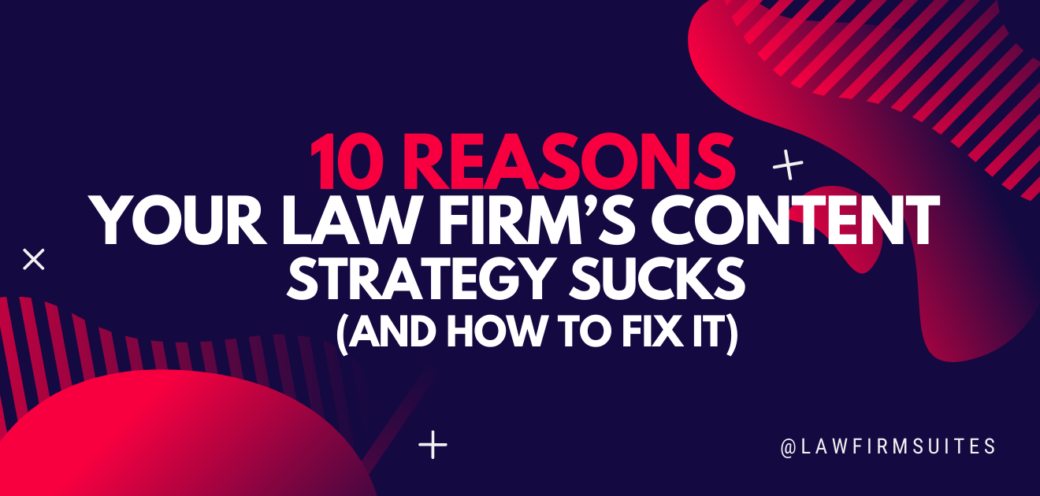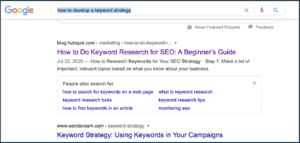Over time, a good content strategy for your law firm can reduce time and dollars spent on marketing, but these common mistakes can turn your content marketing efforts into a waste of time.
A great digital content strategy will significantly support and improve any small law firm’s marketing efforts – even for those lawyers whose primary focus is traditional offline marketing like networking and referral cultivation.
The beauty of a great content strategy is that, as your library of assets gets bigger, it can return dividends in the form of leads and referral sources — often for years. Plus, you can plan and execute a content marketing strategy whenever and wherever, so it doesn’t have to take up valuable business time.
But many lawyers approach content strategy all wrong and when they don’t see immediate results, give up too easily wasting time and resources.
Here are 10 mistakes that prevent lawyers from having an awesome content strategy:
1. You Don’t Have The Right Team (Or Any Team)
Creating good content all on your own is challenging. The success of a good content strategy requires working with several disciplines such as information architecture, design, user experience, and public relations. Small firm lawyers sometimes hear “team” and think: expensive. But it doesn’t have to be.
Initially, consultants and freelancers can be hired to make sure your online assets are set up properly. Often, a good digital content consultant can set-up the technical side of your content strategy and train you on how to execute it using best practices.
After the initial set-up, you can touch base with your team a few times a year to update your set-up based on any changes to the digital content marketing landscape or adaptations you may need based on the KPIs you’ll be tracking (more on that later).
2. You’re Not Paying Enough Attention To Keywords
If you are going to spend time and money on a content strategy as a business development tool, you want your content to show up in search results when prospective customers in your geographic area are looking for services you provide. Any decent SEO expert would tell you that, if you want customers to find your content through search tools like Google, each piece must be focused around one search term, also called a “keyword.”
Brainstorm search terms that prospective customers use to find information about the types of problems your firm solves. These may be “Boolean” searches (i.e., “H1B visa employee Canada”) or natural language searches (i.e., “how do I get an H1B visa for an employee coming from Canada”).
Here is a great beginner’s guide on developing a keyword strategy from content marketing experts Hubspot.
Incidentally, take a look at the way Hubspot uses the advice from this section. I wanted to find a great resource for developing a keyword strategy.
In Google, I searched: “how to develop a keyword strategy”. This was the first article to appear after the ads:
Notice the use of the natural language keyword “how to do keyword research” in the title of the article and in the URL?
3. You’re Writing Style Meets Your Needs, Not Your Audience’s
Your content strategy will only be powerful when you understand exactly who your target client is, and how they think, feel, and talk about the legal issues your firm services. You do this by developing a hypothetical “avatar” of your typical customer.
According to Forbes, in marketing, an avatar is a little fiction that helps us understand who our ideal customers are so we can find them more easily.
It’s a detailed profile of your ideal customer that doesn’t make assumptions or categorize people into groups. The avatar focuses on one person and outlines everything about them.
You can start by assessing what websites and social media platforms your prospective clients visit. You can leverage tools such as Google Analytics and Google Demographics to deepen your research.
Of course, the best way to develop an avatar is to simply ask your clients (preferably recorded in some capacity) so you can go back and listen to the exact language your clients use to describe the challenges they experience. Once you understand this, you can tailor content to suit their needs by repeating the language they use to describe these challenges (which is probably not the same language you might use when speaking with your peers).
Here is one of my favorite resources for developing avatars from Digital Marketer.
Want an insider tip? It’s not a coincidence that the title of this article went negative (why your content strategy sucks) as opposed to being more positive (how to make your content marketing better). After doing the research about our avatar — solo and small firm attorneys — we learned that they respond better to negative headlines over positive by a significant margin.
One last thing: you will likely have more than one avatar in your practice. If this is the case, do this process for each avatar and adapt unique content for each one based on what you learn.
For example, in my business law practice, I represent entrepreneurs and business owners who are starting and building companies. But we also represent the investors and investment bankers who provide funding for these entrepreneurs or assist with business purchases and sales.
While these groups often “swim in the same pond” professionally, they have very different values and use different language. Our firm has an avatar for each group, and our content is always adjusted to appeal to one avatar or the other.
4. Your Content Doesn’t Match Your Audience’s Literacy Skills
A survey of people’s literacy showed that only people with a high literacy rate complete simple tasks on a webpage. A big reason is that content is (inadvertently) created to target intellectuals.
Lawyers are chronically guilty of this.
We are trained to write in a highly analytical manner and tend to use the same “insider” language in our marketing content that we use professionally with peers, adversaries, and courts.
While the vast majority of us have excellent technical writing skills, we are horrible at describing the complex details of our practice so (non-lawyer) clients can understand.
According to marketing guru Seth Godin, clients don’t want to feel stupid. “When the client sees that [a lawyer] is marketing themselves the way they would market themselves, there is this sense of affiliation,” says Godin in a recent legal marketing podcast episode by Ranking.io. Clients will be more attracted to content from lawyers who can communicate on their level.
When you are developing a content strategy, it has to:
- Appeal to your avatar at their literacy level
- Be simple for people to comprehend
- Trigger an emotional appeal
- Inform and entertain at the same time
- Be authentic
Writing for your client’s literacy skill level takes a lot of practice, but you will get better at it over time.
To accelerate your learning process, a simple workaround is to (a) develop that avatar and repeat the language they use often (yes, I’m going to keep saying it); and (b) find a non-lawyer editor who can translate your content into language that is more relatable to prospective customers.
I have had success finding editors through Fiverr who will work for reasonable rates, often on a per-word basis.
Finally, content does not always have to mean “articles”. Consider recording videos or podcasts, or whatever type of media your avatar is most likely to engage with (yup, this will be one more thing you’ll discover if you do the avatar research).
5. You’re Ignoring The 5 W’s
In marketing, it is essential to take into account the 5 W’s: who, what, where, when, and why. These questions tend to provide a checklist for a marketing strategy. Every piece of content you produce should answer those five questions.
Not much more to say about this. You all should already be experts at it.
6. You’re Not Breaking Complex Articles Down With Subheadings
The bottom line, people are lazy readers, especially when it comes to digital content. That’s why it’s important to break your content down into smaller chunks with several sub-headings (it’s not a coincidence that this article is presented in a top 10 tips format).
Often, viewers will scan your title and subheadings first, and if they like what they see, will dive deeper. Without the headings, all they see is a dense page of copy, making it more intimidating and less digestible.
7. You’re Not Using KPI’s To Track Results Or Adjust Your Strategy
Management expert Peter Drucker is often quoted as saying “you can’t manage what you can’t measure.”
A good content strategy should track key performance indicators (KPI’s) to monitor performance. Over time, tracking KPIs will allow you to do more of what’s working and less of what isn’t, maximizing the ROI from your efforts.
There are four categories of KPIs experts recommend:
- Consumption: Works by assessing the rate of the effectiveness of your content by looking at who is viewing content, where they are getting it from, and the time they spend with it.
- Retention: These metrics keep tabs on how captivating your content is to make visitors revisit it. KPIs include unsubscribed email lists, consumer bounce rates, and the percentage of returning customers.
- Engagement: Assesses how your customers interact with your content. KPIs used include assessment of referral traffic, blog comments, as well as email forwards.
- Lead metrics: Tracks new subscribers and completed forms on your website.
8. You’re Not Taking Advantage Of Metadata (Or You Don’t Know What Metadata Is)
According to the Content Marketing Institute, Metadata is information that expresses context and meaning about something. It is a programming guideline used to get search engines to understand the content on your website.
For example, if you showed me a photo of yourself eating ice cream, I can see that it’s you eating ice cream, but I may not be able to tell where you got it, what flavor it was, what time of year it was, who took the photo, and other things like that unless you tell me explicitly. Metadata helps content creators provide better connections so they can reveal related content to their audience, and it makes those connections much more precise.
Blog categories and tags are two of many kinds of metadata used in a content strategy. You may need to work closely with your web developers to develop the metadata for your content strategy. A good metadata plan enhances the user experience on your website and promotes your contents’ visibility in search results.
9. You’re Not Complying With Web Standards
As it relates to content marketing, web standards ensure that your content is displayed in a precise manner across all browsers and devices. It also makes it easy for your content to be indexed by search engines and makes use of new features that have been introduced on a website.
Like metadata above, this is an area that the typical solo should be working on with their web developers (unless you’ve got extensive coding prowess).
Don’t believe me…see this resource from W3 on web standards. I bet you’d much rather be reading federal securities statutes.
10. You’re Not Involving Customers In Content Curation
From a business development perspective, content created or curated by your clients will often be the most valuable assets on your website. No one can describe your typical client’s experience or how your services will enhance their lives better than they can.
If you want a great ROI from the effort you will be putting into a content strategy, you must give customers a platform to tell their stories, and have a strategy to cultivate contributions.
Don’t believe me?
On Law Firm Suites’ entire website, the page with the fourth highest traffic is an article called Should Attorneys Charge a Consultation Fee that was written by our client, solo matrimonial attorney Joleena Louis.
The page with the third-highest traffic is an article called Shop Talk: Clients Who Don’t Pay Piss Me Off. I wrote this article, but not as a principal of Law Firm Suites, but while wearing my lawyer hat. At the time, I was very annoyed with a client who tried to stiff me on a five-figure bill for a corporate finance transaction. I wasn’t trying to sell anything, I was commiserating with peers about an emotional situation that every self-employed lawyer has experienced.
Content written by or featuring your customers will not only draw prospective clients to your website in much greater numbers, but it will keep them engaged with your content for longer periods of time.
Conclusion
There are a number of reasons why I like having a content strategy as part of my firm’s marketing mix:
- You don’t have to use valuable business hours to do it.
- A well-executed piece of content can drive web traffic, leads, and referral sources for years.
- The bigger your content library gets, your payoff greatly improves without adding to your marketing spend.
- A good content library can help you market your practice automatically, in the long run delivering way more value than you spend in time or money.
- It’s about helping people, and when a piece of content really resonates with an audience, it’s a very rewarding feeling that encourages you to create more.
Stay away from these 10 mistakes, and your content strategy will support your practice for years to come (and it will suck a lot less)!
About the Co-Author
This article was co-written with Leonie Walton. Leonie is an experienced website developer and SEO specialist with a demonstrated history of working in the marketing and advertising industry. She possesses a strong entrepreneurial mindset and has devoted her career to enhancing the sphere of digital marketing. In her methodological approach, she integrates web development and other digital marketing solutions to create hybrid strategies that bring the best results.





